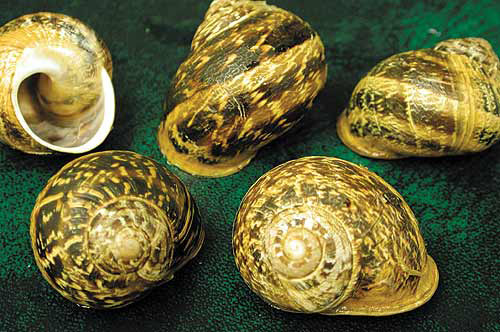Note: Cornu aspersum was previously known as Helix aspersa.
Hosts
Cornu aspersum feeds on a wide variety of vegetables, flowers, fruit, ornamental plants and weeds. Dead animal tissue and paper products are also eaten.
Distribution
- Asia: Türkiye, borders of the Black Sea
- Africa: Algeria and South Africa
- Pacific: Australia (Queensland, Tasmania), New Zealand
- Europe: Great Britain (mainly southern and coastal), Belgium, France, Germany, Greece, Ireland, Italy, Portugal, Spain
- Islands: Canary Islands, Haiti
- North America: Mexico, United States (Arizona, California, Hawaii, Idaho, Louisiana, Nevada, New Mexico, Oregon, Texas, Utah, Washington)
- South America: Argentina, Chile
Biology
Cornu aspersum, like other snail species, is a hermaphroditic species (each individual having both male and female reproductive systems). Mating is nocturnal and lasts from 4-12 hours during which time mutual fertilization occurs via the exchange of sperm. Oviposition occurs 3 to 6 days after fertilization (both partners lay eggs).
White spherical eggs are deposited into a nest excavated in soil by the snail. The nest is about 2.5 to 4.0 cm deep and on average will contain about 86 eggs. The egg mass is concealed by a mixture of soil and mucus capped by a layer of excrement. Low temperature and low humidity reduce the frequency of oviposition.
Warm, damp environments are ideal and under such conditions oviposition may occur once a month. Eggs hatch in about two weeks, with the young snails remaining in the nest for two to four days. The young snails then emerge from the nest and begin feeding on the first suitable vegetation they encounter. The snails may take up to two years to mature, the rate of maturation being determined by the concentration of calcium in the environment.
In cold weather the snail buries itself in soil, seals the shell with a sheet of hardened mucus and becomes dormant. Under dry conditions the snail sticks down onto a harden surface and seal its shell to avoid desiccation. This species can survive -10°C becoming active between 4.5°C and 21.5°C.
Detection and identification
Detection
- Ragged holes chewed in leaves, with large veins remaining
- Holes in fruit
- Slime trails and excrement on plant material
Identification
- Eggs: round, white, about 3 mm in diameter.
- Juveniles: Shell with one whorl only when newly hatched, smooth, light brown, speckled black, lacking any pattern of bands and flecks.
- Adult shell:
- 4½ to 5 whorls; thin, moderately glossy, sculptured with wrinkles the last whorl especially with coarse unequal wrinkles of growth and a network of smaller wrinkles running together. The last whorl descends in front and the opening of the shell, or lip, is turned back.
- 32 to 38 mm in diameter, 29 to 33 mm in height.
- yellow to yellowish brown to greyish brown, with five brown bands, interrupted by yellow flecks or streaks.
- Head and foot: are 5 to 6 cm long when extended, yellowish-grey to greenish-black, with a pale line along the back from the base of the tentacles to the shell.
Inspection method
Adults and larger sized juveniles are likely to be visible among the host material or attached to the transporting containers. They may also be hidden in protected locations, sealed into their shells, avoiding desiccation. Check the underside of containers and their rims, etc. Small snails and eggs in soil could be difficult to find. C. aspersum likes to hide in crevices and will over winter in stony ground.
Snail surveys
Are best carried out under wet, warm and dark conditions. Under bright, dry conditions it is necessary to thoroughly search dark sheltered areas where the humidity is elevated, such as under low-growing plants or backyard debris. It should be realized that these snails may bury themselves in loose soil or other matter, so the only way we can be reasonably sure an area is not infested is to make repeated surveys over a long period of time.

Synonyms
- Cantareus aspersus
- Cryptomphalus aspersus
- Helix aspersa